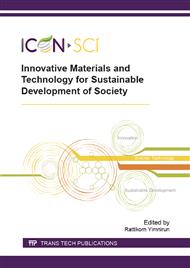[1]
R. A. Stermer, H. W. Schroeder, A. W. Hartstack Jr and C. H. Kingsolver, A Rice Photometer for Measuring the Degree of Milling of Rice, Rice. J. 67(5) (1962) 24-29.
Google Scholar
[2]
R. A Sterner, An Instrument for Objective Measurement of Degree of Milling and Color of Milled Rice, Cereal. Chem. 45(4) (1968) 358-364.
Google Scholar
[3]
K. J. Chen and M. Huang, Prediction of Milled Rice Grades Using Fourier Transform Near-Infrared Spectroscopy and Artificial Neural Networks, J. Cereal. Sci. 52 (2010) 221-224.
DOI: 10.1016/j.jcs.2010.05.010
Google Scholar
[4]
J. G. Wu, C. Shi and X. Zhang, Estimating the Amino Acid Composition in Milled Rice by Near-Infrared Spectroscopy, Field. Crop. Res. 75 (2002) 1-7.
DOI: 10.1016/s0378-4290(02)00006-0
Google Scholar
[5]
J. S. Bao, Y. Z. Cai and H. Corke, Prediction of Rice Starch Quality Parameters by Near-Infrared Reflectance Spectroscopy, J. Food. Sci. 66(7) (2001) 936-939.
DOI: 10.1111/j.1365-2621.2001.tb08215.x
Google Scholar
[6]
M. Sohn, F. E. Barton, A. M. McClung and E. T. Champagne, Near-Infrared Spectroscopy for Determination of Protein and Amylose in Rice Flour Through Use of Derivatives, Cereal. Chem. 81(3) (2004) 341-344.
DOI: 10.1094/cchem.2004.81.3.341
Google Scholar
[7]
H. A. Rahim and S. Ibrahim, Near Infrared Spectroscopy Measurement the Assessment of Amylose Content in Rice Grain, J. Sensor. & Transducer. 156(9) (2013) 251-258.
Google Scholar
[8]
J. Rash and J-F. Meullenet, Apparent Amylose Content Prediction using Near Infrared Spectroscopy of Individual and Bulk Rice Kernels, B.R. Well. Rice. Res. Studies. 591 (2010) 312-321.
Google Scholar
[9]
J. G. Wu and C. H. Shi, Prediction of Grain Weight, Brown Rice Weight and Amylose Content in Single Rice Grains Using Near-Infrared Reflectance Spectroscopy, Field. Crop. Res. 87(103) (2004) 13-21.
DOI: 10.1016/j.fcr.2003.09.005
Google Scholar
[10]
P. Thenjumpol, S. Ripon, S. Karaboon, K. Suwapanit, S. Thanapornpoonpong and S. Vearasilp, Aromatic Thai Rice Identification by Near-Infrared Reflection Spectroscopy. Paper presented at Conference on International Agricultural Research for Development (2005).
Google Scholar
[11]
Y. -K. Chuang, Y. -P. Hu, I-C. Yang, S. R. Delwiche, Y. M. Lo, C. -Y. Tsai and S. Chen, Integration of Independent Component Analysis with Near Infrared Spectroscopy for Evaluation of Rice Freshness, J. Cereal. Sci. 60 (2014) 238-242.
DOI: 10.1016/j.jcs.2014.03.005
Google Scholar
[12]
M. S. Prasad, CH. Madhu, G. Venkateshwalu and M. Sabath, Quantitative Evaluation of Carbohydrate Levels in Different Natural Foodstuffs by UV-Visible Spectrophometer, Asian. J. Pharn. Ana. 2(1) (2012), 10-11.
Google Scholar
[13]
D. Nawapat and W. Thawien, Effect of UV-Treatment on the Properties of Biodegradable Rice Starch Films, Int. Food. Res. J. 20(3) (2010) 1313-1322.
Google Scholar


